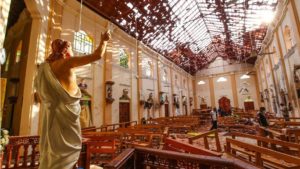How the external debt trap (mainly by Chinese), has led to perilous situation of Sri Lanka’s economy!


Sri Lanka is a land of many business opportunities. But the government is not investing in them or atleast they don’t encourage foreign investors to invest in them.
How did Sri Lanka become bankrupt?
Broadly, three reasons worked over time to push Sri Lanka into an economic crisis.

Tourism suffered since the Easter Sunday terror attacks of 2019. Incoming Foreign Exchange fell from $3.6 billion in 2019 to just $0.7 billion in 2020.
Also, FDI inflows halved from $1.2 billion to $670 million over the same period.

Tourism industry represents 10% plus of the country’s GDP and major foreign exchange earner. This resource dried up due to the coronavirus pandemic. FOREX reserves dropped from over $7.5 billion (2019) to $2.8 billion (July ’21).
Sri Lanka is then forced to buy FOREX with hard currency and this resulted in rupee depreciation by 8% (so far). Since the country depends heavily on imports to meet even its basic food supplies, prices of food items have risen in line with the weakening rupee.

The government’s ban on the use of chemical fertilizers in farming severely affected agricultural production. Sri Lankan tea expert Herman Gunaratne says, continued forced push on organic farming will only worsen the shortages in the coming years and will have direct effect on produce for domestic food consumption and also on export items like tea. The latter will have seriously worsen the current economic crisis.
Still, the government refuses to stall this aggressive push, claiming that the short-term pain will be compensated by its long term benefits.
Indo-Lankan economic relations
What Sri Lanka crisis means to India?
The crisis may further push Sri Lanka to align its policies with Beijing’s interests. This is at a time when India is already on a diplomatic tightrope with Afghanistan and Myanmar. Just to add, Other South Asian nations like Bangladesh, Nepal and the Maldives have also been turning to China to finance large-scale infrastructure projects.
The Sri Lankan rupee has plunged to a record low against the US dollar. Annual inflation is in the double digits. Import controls are in effect. And the country is teetering on the edge of default. An unprecedented economic crisis is unfolding in Sri Lanka. And while the country’s problems have been brewing for years, spillovers from the crisis in Ukraine have sent the island nation over the edge.
The power blackouts have become a norm. Fuel, food and medicine – most of which are imported – are scarce, and rising prices are putting what remains out of reach for many Sri Lankans. Even printing paper is hard to come by, forcing schools to cancel exams. The problems have sparked the biggest protests seen here in years and troops have been stationed in to quell them. Sri Lanka is now turning to foreign assistance for help, including its two biggest trading partners. China is considering offering $2.5 billion more over the $2.8 billion already extended and India has put up $2.4 billion. And President Gotabaya Rajapaksa’s government is currently in negotiations with the International Monetary Fund and the World Bank for a bigger aid package – something he had previously resisted, to avoid the often onerous terms they require.
Now the economic, financial and political stability of Asia’s oldest democracy are all at risk if the government does not find a sustainable way out. Sri Lanka, which gained its independence from Britain in 1948, only recently emerged from a deadly and costly 26-year civil war. The war was fought between the government military of this majority Sinhalese country and armed separatists from the Tamil-speaking minority.
Toward the end of the war, in 2006, the government tried to jumpstart growth by borrowing heavily and attracting foreign capital by propping up the rupee. In the short term, the strategy worked. The economy boomed, causing the per-capita gross domestic product to surge from $1,436 in 2006 to $3,819 in 2014 – vaulting Sri Lanka past Ukraine, the Philippines and Indonesia. This lifted 16 lakh people out of poverty – 8.5% of the population – and gave rise to a large middle class. By 2019, Sri Lanka ascended to the ranks of the World Bank’s “upper middle-income” countries.
The designation lasted only for a year, however, because all that growth came at a cost. Sri Lanka’s external debt tripled from 2006 to 2012, pushing the total public debt to 119% of GDP. Those policies were suspended for a time in 2015, which stabilised the economy at a lower rate of growth, but the debt continued to accumulate.
Then the Covid-19 pandemic hit. Tourists, who spent $5.6 billion in 2018 and played a big role in balancing Sri Lanka’s $10 billion trade deficit, disappeared virtually overnight. This dealt a massive blow to the economy, especially considering a large tax cut the previous year depleted government coffers. Simply paying interest on that large debt took up 72% of government revenue in 2020, requiring the central bank to print more cash to avoid default, thus fueling inflation.
Fortunately for the government and its citizens, Sri Lankans overseas continued to send home a vital lifeline of remittances, or about $7 billion a year. But in 2021, as many economists and analysts urged Sri Lanka to seek international aid, the central bank instead focused on borrowing from its neighbours, maintaining the value of the Sri Lankan rupee and restricting imports.
The export controls caused shortages of essential goods like cooking gas and milk, and defending the currency drained Sri Lanka’s foreign reserves. Moreover, remittances began to drop as the black market value of the rupee fell, leading people to avoid converting US dollars to Sri Lankan rupees at the official rate or by official channels. Annual inflation has been estimated at as much as 55%, compared with the official rate of 14%. By March, reverberations from the war in Ukraine, which drove up international prices of oil, wheat and many other commodities, finally forced the government to change course. Beyond the effect on the cost of imported goods, the war also further threatens Sri Lanka’s tourism industry as flights to Moscow are now suspended. Before the war, Russians frequently made up the biggest share of Sri Lankan tourists, with Ukrainians not far behind.
Sri Lankan authorities had few other options than to allow the rupee to depreciate – which is expected to save billions of dollars a year – and seek International Monetary Fund assistance. Sri Lanka will likely also have to restructure its large debt load – by asking foreign bondholders to accept less than 100% of the value of their investments – to make it more sustainable. The strategy may be working, but the cost to Sri Lankans will be high for a long time. Over 350 “non-essential” items are now banned for import, including milk, oranges and household appliances.
And the limited supply of goods that remain are getting more expensive every day. The price of cooking gas, for example, is almost three times higher than it was just five months ago. Securing loans from the International Monetary Fund and the World Bank, along with short-term credit from China and India, may stabilise Sri Lanka’s economic and financial situation. But with protests growing and the austerity measures demanded by the lenders likely to prove unpopular, the government may find it hard to survive for long.
DISCLAIMER: The author is solely responsible for the views expressed in this article. The author carries the responsibility for citing and/or licensing of images utilized within the text.
